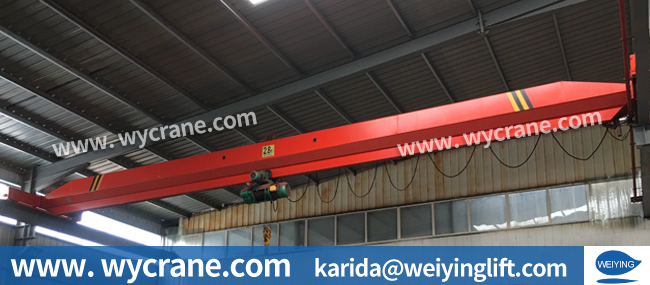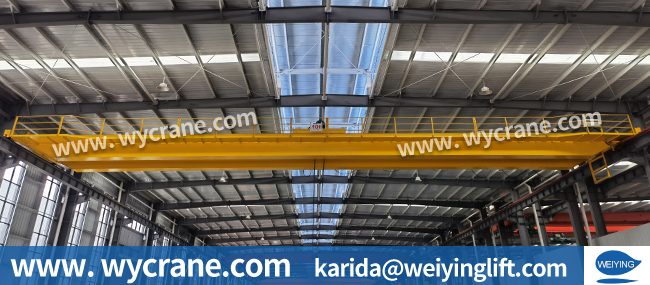In factories, warehouses, and port yards, overhead bridge cranes are the backbone of heavy lifting, streamlining workflows and reducing manual labor. But when it comes to choosing between single girder and double girder models, many businesses struggle: What sets them apart? Which one fits your needs? This article breaks down their features, differences, and selection tips to help you make an informed decision.
Ⅰ.What Is an Overhead Bridge Crane?
An overhead bridge crane is a lifting device that operates on elevated rails (installed along the top of factory columns or support structures). Its core structure includes:
- A “bridge” (main beam) that spans the width of the work area.
- End trucks (at both ends of the bridge) that move the crane along the longitudinal rails.
- A hoisting mechanism (with a hook, grab, or magnet) that lifts/lowers loads and travels horizontally along the bridge.
Widely used in manufacturing, metallurgy, mining, and logistics, it’s known as the “airborne mover” for its ability to maximize floor space and handle heavy loads efficiently.
Ⅱ.Single Girder Overhead Bridge Crane: Ideal for Light-to-Medium Lifting
Single girder cranes are the most common choice for small-to-medium operations, thanks to their simplicity and cost-effectiveness.

Key Features
1. Working Conditions
- Load capacity: Designed for light-to-medium loads, typically 0.5–20 tons .
- Frequency: Suits low-to-moderate usage , not continuous heavy-duty work.
- Scenarios: Small machine shops, maintenance workshops, small warehouses, or assembly lines where lifting small parts or light equipment is needed.
2.Structure
- Core design: A single main beam (usually made of I-beam or light box-section steel) – simple and compact.
- Hoisting system: The hoist (motor + reducer + drum) is directly suspended under the main beam via a trolley, which moves along the beam’s rail.
- Space efficiency: Takes up less vertical/horizontal space, making it perfect for factories with low ceilings or narrow work areas.
3.Manufacturing & Maintenance Costs
- Initial cost: 30–50% lower than double girder cranes. Less steel is used, and the manufacturing process is simpler.
- Installation: Easy to assemble on-site, requiring minimal labor and time.
- Maintenance: Fewer components mean lower upkeep costs. Parts like the hoist or trolley are easy to access and replace.
4. Physical Performance
- Span limit: Typically 5–22 meters (wider spans risk beam deflection under load).
- Stability: Moderate – the single beam bears all the load, so it’s not ideal for unstable or high-vibration environments.
- Speed: Hoisting and traveling speeds are moderate, matching light-duty needs.
Ⅲ.Double Girder Overhead Bridge Crane: Built for Heavy-Duty & Large-Span Work
Double girder cranes are engineered for high-intensity, heavy-lifting tasks where stability and capacity are non-negotiable.

Key Features
1.Working Conditions
- Load capacity: Starts at 10 tons and goes up to 500 tons+ .
- Frequency: Handles continuous, high-frequency operation , such as port container loading or metallurgical production.
- Scenarios: Heavy machinery factories, steel plants, ports, and large warehouses where oversized, ultra-heavy loads need to be moved.
2.Structure
- Core design: Two parallel main beams. The beams are connected by crossbars to form a stable rectangular frame.
- Hoisting system: The hoist is mounted on a trolley between the two beams, ensuring smoother travel and even load distribution. Many models add a secondary hoist for flexible light-load lifting.
- Durability: Reinforced end trucks and thicker steel ensure the crane can withstand long-term heavy use.
3.Manufacturing & Maintenance Costs
- Initial cost: Higher than single girder cranes. More steel, precision welding , and complex assembly drive up costs.
- Installation: Requires professional calibration and may need reinforced factory columns, increasing setup time.
- Maintenance: Focuses on wear parts and beam alignment. While costs are higher, the crane’s lifespan is longer than single girder models .
4.Physical Performance
- Span limit: 10–35 meters (custom models can exceed 40 meters for large facilities).
- Stability: Excellent – the dual-beam design distributes loads evenly, reducing vibration and minimizing deflection.
- Precision: Higher positioning accuracy than single girder cranes, critical for tasks like assembling precision heavy equipment.
Ⅳ.Single Girder vs. Double Girder: Core Differences
To make comparison easier, here’s a side-by-side breakdown:
| Comparison Dimension |
Single Girder Crane |
Double Girder Crane |
| Load Capacity |
0.5–20 tons |
10–500+ tons |
| Span Range |
5–22 meters |
10–35+ meters |
| Working Frequency |
Low-to-moderate |
High |
| Main Beam Material |
I-beam / Light box-section steel |
Heavy-duty box-section steel |
| Initial Cost |
Low |
High |
| Maintenance Cost |
Low |
Moderate-to-high |
| Best For |
Small factories, workshops, light lifting |
Steel mills, ports, heavy machinery lifting |
Ⅴ.How to Choose the Right One? 3 Key Tips
Your choice depends on practical needs, not just cost. Here’s what to prioritize:
Define Your Load & Usage:
If your max lift is ≤15 tons and you use the crane occasionally: Go for single girder.
If you need to lift ≥20 tons or run the crane 8+ hours/day: Double girder is a must.
Check Your Workspace Span:
For spans ≤20 meters: Single girder works.
For spans >20 meters: Double girder’s stability avoids beam deflection.
Balance Budget & Longevity:
Short-term, light use: Single girder saves money upfront.
Long-term, heavy use: Double girder reduces downtime and replacement costs .
Final Thoughts
Single girder overhead bridge cranes are the “economic choice” for light tasks, while double girder models are the “reliable workhorse” for heavy-duty operations. Choosing the wrong one can lead to safety risks or wasted budget .
Always verify that the crane meets local safety standards and consult a professional manufacturer for custom needs. With the right selection, your overhead bridge crane will boost efficiency and last for decades.
If you want to learn more, please contact us.
E-mail address: karida@weiyinglift.com
Website: www.wycrane.com

